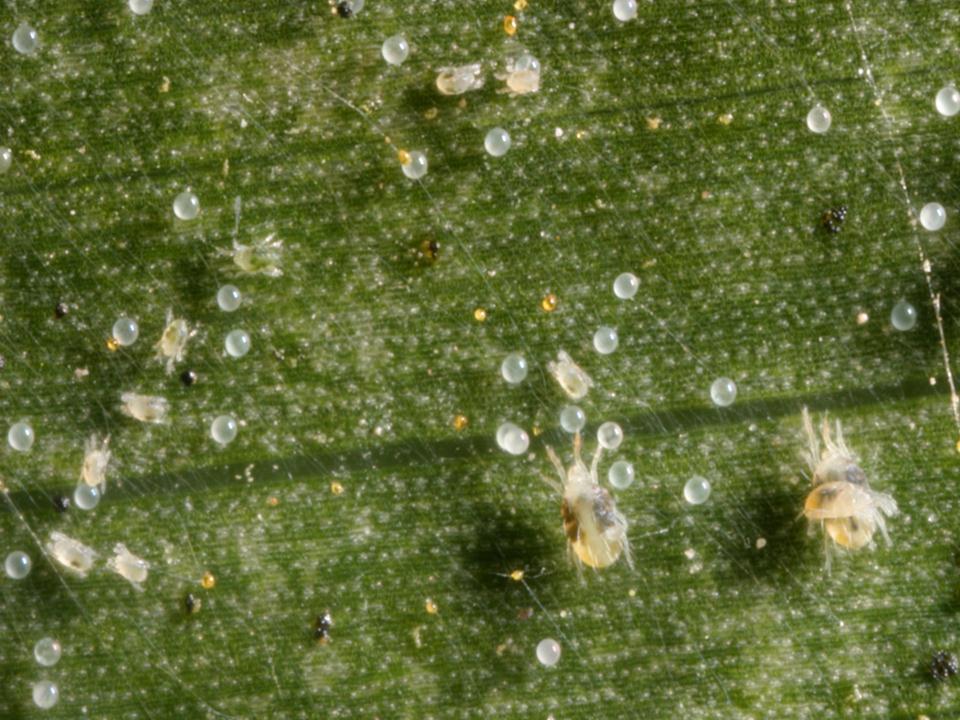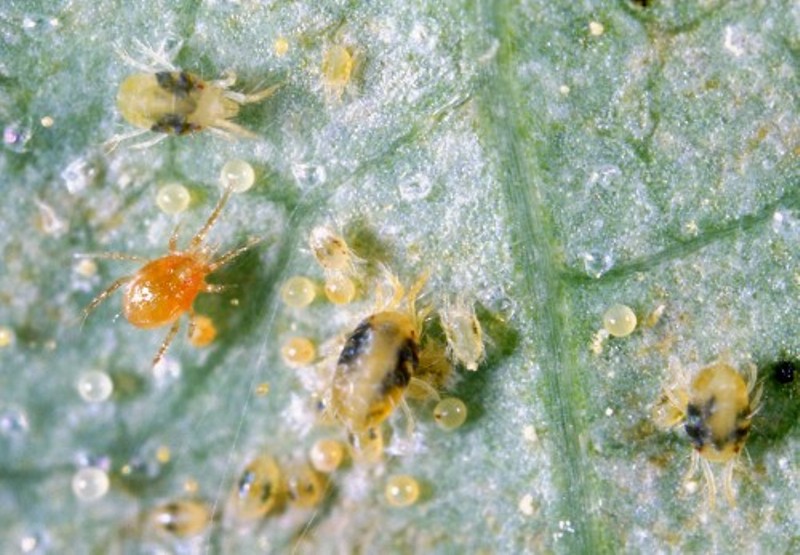2 Spot Spider Mite
Quick facts
- Twospotted spider mites can infest over 200 species of plants.
- Severe spider mite feeding can stunt a plant's growth and can even kill the plant.
- Use nonchemical steps, such as keeping plants healthy, to protect plants.
- There are few pesticides available for treating twospotted spider mites; insecticidal soaps and horticultural oils are the most common.
Two-spotted spider mites are taking advantage of the 2020 growing season’s hot weather. Mite infestations have been observed in soybean fields in Brown, Carver, Dakota, Le Sueur, McLeod, Lac Qui Parle, Redwood, Stearns and Yellow Medicine Counties.
- Twospotted spider mite sampling is done by looking at the undersides of 60 randomly chosen young, fully expanded leaves from different plants in an area of about 100 sqyare feet around the “hot spot.”.
- Two-spotted Spider Mites: Spider Mites & Soybeans Spray Smarter Prolonged drought always raises the specter of two-spotted spider mite (Tetranychus urticae) infestations in soybeans and corn.
- Spotted Spider Mite (TSSM ). Accumulated mite days ( ± standard error) from 5 August to 1 October 2002 for strawberry plants assigned to different levels and timings of feeding injury by Two-spotted Spider Mite (TSSM). Accumulated mite days provides a quantitative assessment of mite injury to plants and is determined by multiplying.
How to identify twospotted spider mites
The two-spotted spider mite, Tetranychus urticae, is a type of arachnid, related to insects. Other arachnids include spiders and ticks. All arachnids, including mites, have two main body parts and eight legs.
- They are very tiny, about 1/50th of an inch long.
- Yellow-orange in color, with two dark spots, one on each side of the body.
- When a heavy infestation occurs webbing will also be present.

Biology of twospotted spider mites
Twospotted spider mite attacks 100’s of plants in gardens and landscapes including:

- Fruits, such as blackberry, blueberry, and strawberry
- Vegetables, such as cucumbers, snap beans, peas, tomatoes, and lettuce
- Annuals and perennials, such as lantana, marigolds, New Guinea impatiens, salvia, and viola
- Trees and shrub, such as arborvitae, azalea, spruce, and rose
Twospotted spider mite infestations are particularly common during hot, dry summer weather.
- They live through the winter as eggs on vegetation.
- Larvae hatch and complete development in 1-2 weeks depending on the temperature.
- Under high temperatures (>90°F) colonies can reach high numbers in less than two weeks.
- After hatching, the mites build colonies on the undersides of leaves and produce webbing over infested leave surfaces. This webbing gives them the name 'spider' mites.
Damage caused by twospotted spider mites
- They use piercing-sucking mouthparts to feed on the sap on the underside of leaves and needles.
- This injury produces tiny white or yellow spots, giving leaves and needles a stippled or mottled appearance.
- As feeding becomes more severe, plants look bronzed or bleached and leaves may drop.
- Some plants, like azalea, may develop distorted leaves and flowers.
- Webbing indicates a spider mite infestation.
- These symptoms may be confused with drought stress.
- Severely infested plants can be damaged and can even cause plants to die.
How to protect your plants from twospotted spider mites
Check plants regularly for spider mites
- Examine plants for stippling and/or webbing.
- Look closely with a hand lens on the underside of discolored leaves for the presence of spider mites.
- You can also hold a white piece of paper or cardboard underneath potentially infested leaves; shake the leaves and look for spider mites that have fallen.
- Check garden plants every 3-5 days, especially under drought conditions.
Keep plants healthy
Spider mites thrive on plants under stress. Keep plants well-watered to reduce the chances of a spider mite attack.
- Most plants should receive about one inch of water a week to avoid stress conditions.
- Conserve moisture through proper mulching.
- Select drought-tolerant plants for locations that are particularly hot and dry.
- Do not fertilize plants during drought, as this can add further stress to plants.
- Do not overwater as this can lead to root rot.
Physically remove them
Use a high-pressure water spray to dislodge twospotted spider mites. This can also wash away their protective webbing.
Natural enemies can reduce twospotted spider mites
Certain species of lady beetles (e.g. Stethorus sp.) and predatory mites (e.g., Phytoseiulus persimilis) naturally control twospotted spider mite populations.
If the twospotted spider mite population is high, natural enemies are less effective at controlling them.
Using long-lasting pesticides like bifenthrin and permethrin kill natural enemies and should be avoided to encourage natural enemies.
Using pesticides
There are few pesticides available for use in home gardens and landscapes that are effective against twospotted spider mites.
Insecticidal soap and horticultural oil
Insecticidal soaps are made from potassium salts of fatty acids (don’t make a homemade soap solution as this can burn and damage plants). Horticultural oils are made from either petroleum oils, vegetable oils (like cottonseed oil), or neem seed oil.
Soaps and horticultural oils are reasonably effective against mites and have little impact on people, animals and nontarget insects.
These products will only kill mites that the pesticide directly contacts. They do not have any residual activity.
Two Spotted Spider Mite Trap

2 Spotted Spider Mite Life Cycle
Target the underside of leaves as well as the top.
Repeat applications may be needed.
Residual pesticides
Long-lasting insecticides, such as bifenthrin and permethrin can be used on twospotted spider infestations. However, these insecticides also kill natural enemies and could possibly make infestations worse in the long run.
Twospotted spider mite infestations occur when it is hot and dry.
Water plants thoroughly before spraying pesticides for spider mites.
Spray in the early morning or early evening.
These steps will reduce the risk of further stressing plants and causing injury.
CAUTION: Mention of a pesticide or use of a pesticide label is for educational purposes only. Always follow the pesticide label directions attached to the pesticide container you are using. Remember, the label is the law.
If twospotted spider mites continue to be a problem after control efforts have been attempted, and the plants are valued, consider hiring a landscape professional to treat them. Landscape professionals have the training, experience, and wider array of pesticide products to effectively deal with spider mite infestations.
Reviewed in 2020
It is that time of year again, when the two-spotted spider mites (Tetranychus urticae; TSSM, Figure 1), and other mite species, show up in full force and wreak havoc on fruit and vegetables. These pests are very inconspicuous and often go unnoticed until the resulting damage appears. For TSSM this includes the webbing produced on heavily infested leaves or to the more trained eye, the characteristic yellow speckles or mottled symptoms on the upper surface of the leaves (Figure 2 and 3). The mites can be found on the underside, feeding with their sucking mouthparts.
Figure 1. Eggs, larvae, nymphs and adult two- spotted spider mites. (Photo by J. Obermeyer)
Figure 2. Yellow speckles on the upper surface of cucumber leaves heavily infested by two-spotted spider mites.
Figure 3. Webbing produced on heavily infested cucumber leaves by two-spotted spider mite.
Cucumber, especially in organic production, can be the most susceptible. However, this pest feeds on a wide range of plants including tomatoes, melons, peppers, strawberries, apples, pears and grapevines, as well as flowers and field crops. Regardless of your production technique, an intervention is almost always necessary to control TSSM. In high tunnels in particular, pest populations thrive under hot and dry conditions and can wipe out a crop in a couple short weeks if no control measures are taken. Here is the best advice that I can offer, from my own experiences of growing cucumbers in high tunnels for four years and consulting with some beneficial suppliers in the region:
If the infestation of TSSM is at the point where webbing is visible on some leaves, especially in high tunnels, chemical intervention is necessary before introducing beneficial predators. There are a variety of miticides that have been effective in the past, leading to control with only one application. We have used Portal® in the past, which has since been prohibited in greenhouses. Ones that are currently silent on the label, and therefore may be used in high tunnel production depending on your local interpretations, include Acramite®, Agri-Mek® and Oberon®. These products can be used in both cucumber and fruiting vegetables. An organic alternative may include various insecticidal soaps, which kill on contact so should be carefully applied to the underside of leaves where the pests are feeding.
If you are considering beneficials for control, there are a variety of predatory mites and a midge available for purchase. Phytoseiulus persimilis is a predatory mite that only feeds on TSSM and can be effective at getting an outbreak under control. They become less active at temperatures around 90-95˚F. The predatory midge Feltiella acarisuga are available for purchase as pupae in plastic trays. They take about 3 weeks to establish in the crop and provide control of TSSM as well as other mite species. The larval form of this insect feed on the mites and can resemble syrphid fly larvae, which are common and feed on aphids. There are a variety of Amblyseius species, another predatory mite, that can establish and maintain long term control. The species that is most heat-tolerant and therefore suitable for high tunnels at this time is Amblyseiuscalifornicus. They remain active at temperatures up to 110 ˚F.